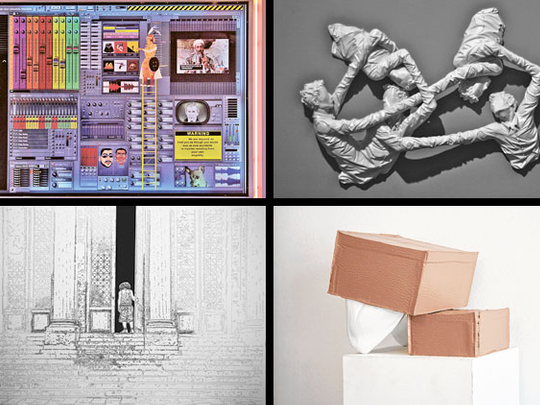
‘Canon’, by Florian Hafele;
‘Handle With Care’, by Mathias Garnitschnig
‘I Saw It. I Walked Up the Stairs and Opened the Door’, by Farshid Larimian. Image Credit: Supplied
Division by zero is not allowed in mathematics. It is a paradox that can make computers crash. But young emerging artists Anahita Razmi, Mathias Garnitschnig, Amir Habib, Farshid Larimian and Florian Hafele do not recognise such restrictions in their art. The title of their group exhibition in Dubai, Division by Zero, indicates their desire to defy norms and push the boundaries of creative expression. The five artists come from different countries and backgrounds and their work ranges from sculptures and paintings to installations and video art. They may lack the sophistication that comes with experience and age but their work has the freshness, energy and irreverence of youth.
Razmi is of Iranian and German origin and won the prestigious EMDASH Award at the Frieze Art Fair this year. Her video, titled How Your Veil Can Help You In Case of An Earthquake (Lesson 1-8), refers to the devastating earthquake in Bam, Iran, in 2003 and is her reaction to the fact that the country's leaders were more concerned about women wearing veils than helping those who had lost their homes and dear ones. In the video, Razmi demonstrates many ways to use the veil during an earthquake — such as tying it over your mouth to keep the dust out, extinguishing a fire, wrapping fragile precious objects and protecting your head from falling debris. It is shot in stark black and white and her deadpan tone and expression are like that of an air hostess demonstrating safety procedures during a flight. The tongue-in-cheek performance makes strong statements about issues such as the leadership in Iran and around the world, female identity, Islamophobia and the vulnerability and frustration of ordinary people. Similarly, her photographic work, titled Miss Atomic Bomb, references American propaganda photographs of the 1950s to comment on the ongoing debate about Iran's nuclear programme. Here the artist poses as a beauty queen wearing a crown and a swimsuit shaped like nuclear mushroom clouds.
Pakistani artist Habib also uses humour to comment on the situation in his country. His neon-lit billboard-like installation, titled Bad Architecture is Terrorism, is a comment on the architects of his country, who have failed in their responsibility of nation building but speak proudly about their achievements. "Too many things are going wrong in Pakistan and this work is about the things that I don't like about my country," he says. Habib has used a digital print of a sound software as the backdrop of his piece. In the help menu are listed institutions that need help, such as the Supreme Court, the electricity board, the police force and Pakistani cricket. The volume panel indicates that the level of corruption is high while that of resources is low. There are references to history through miniature portraits of great kings of the past and comments on various contemporary issues, ranging from disagreements between the Eid moon sighting committees to terrorism and American intervention in the region. The metaphor of bad architecture is stretched further to show Osama Bin Laden holding a mike shaped like the bombed twin towers in New York.
Larimian's painting, titled I Saw It. I Walked Up the Stairs and Opened the Door, is a more personal work. The artist comes from a small town in Iran and is happy to have received a scholarship at the University of Visual Arts in Vienna. His charming pen drawing on foam board depicts himself as a child walking up the stairs of his university towards a bright future. The door at the head of the stairs has been cut out from the foam board with a fabric pasted over it to allow light to shine through.
Garnitschnig and Hafele are both sculptors from Austria. Garnitschnig's latest plaster of Paris and papier mache sculptures are inspired by everyday packaging materials such as cardboard and Styrofoam. He is also showing a series of "over paintings", where he has painted over pages from magazines, hiding the faces of the people to comment on how we perceive and react to what we see in the media.
Hafele is a skilled wood carver and sculptor. The artist uses the human body to reflect on questions of social environment and its related phenomena. In an earlier series he focused on the pressures caused by our performance-oriented society through sculptures of sportsmen. His latest series, titled Social Panopticum, focuses on ordinary people who face similar stress. The faceless, white figures sculpted from melted recycled plastic symbolise the anonymous people who make up the fabric of society. Wooden blocks of different shapes stuck on the figures perhaps signify the physical and mental strain they bear as they push themselves to perform their roles within the family, the workplace and society. Hafele's acrylic wall sculpture, Canon, also plays with human forms to create a contemporary interpretation of classical murals.
Division by Zero will run at Carbon 12 gallery until September 15.
- Jyoti Kalsi is an art enthusiast based in Dubai.












